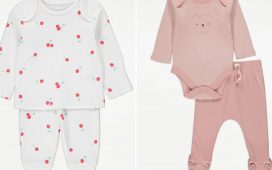Erick Bouwer’s baby son Joshua was, to use a technical term, a whopper: 4.5kg, or almost 10lb in old money. “That was a big guy indeed, he’s 11 years old now and he still is,” says Bouwer, on the line from Amsterdam. Bouwer and his wife had nested assiduously before Joshua’s arrival, supplemented with presents from friends and family, but arriving home from hospital, they realised that none of the onesies and cute cardigans would fit their new arrival. Bouwer laughs, “We were, like, ‘OK, we’ve got a bunch of clothes here, but I hope we’ve still got the receipts.’”
A decade on, Bouwer’s “personal frustration” became a business, Circos. All parents know there is a relentless churn with children’s clothes, especially when your kids are growing fast: leggings are worn once and come back with holes in both knees; jackets fit snugly for a month before having to be retired. Bouwer, then a pricing strategy consultant, dug deeper. He found that, on average, parents use 280 items of clothing for their child before his or her second birthday. Items are typically worn for around two or three months. After that, only 15% of clothing is donated or recycled. Most of the remainder ends up in landfill.
Bouwer’s solution, a somewhat radical one, is that parents should think about renting clothes for their children. He partnered originally with an eco-friendly Danish company, Vigga, which offered a similar but more limited service for baby clothes and maternity wear in Denmark. But Circos was born in May 2019 with a more comprehensive, Europe-wide offering: alongside Vigga’s own-brand gear, there was a selection from Adidas and Patagonia that can outfit a child from birth to the age of four, as well as their mother during pregnancy. Then, in January, Bouwer, 41, announced a major coup. The Swedish brand Arket, part of the H&M group, was joining Circos. Bouwer’s dream of a one-stop shop for renting children’s clothes was starting to look like a realistic proposition.
Realistic maybe, but still, perhaps, a step too far for many parents. Renting clothes, and not just for special occasions, has already become a boom sector for adults. Rent the Runway led the way in the US, offering pieces from more than 700 designers on a subscription plan starting at $89 a month. It has been followed in the UK by platforms such as By Rotation, Hurr and My Wardrobe HQ. And there is a strong environmental case for borrowing clothes rather than buying them. The fashion industry accounts for 10% of global greenhouse-gas emissions, more than all flights and shipping combined. Just while you read the previous sentence, four to five trucks of textile waste will have been burned or landfilled.
So rental makes sense, but many parents – even before the military-grade sleep deprivation kicks in – are not sensible nor rational people. We worship our children like little princelings and princesses, and you can hardly expect royalty (especially those cherished first-borns) to knock around in rented or secondhand duds. Parents are also highly sentimental and weirdly so about clothes: I once made the whole family go on a two-hour search for my daughter’s lost glove. For some, the idea of renting – and then having to send back – say, the tiny shoes in which they took their first steps (worn, not quite Hemingway-style, but maybe twice?) seems frankly inhumane.

Bouwer, who besides Joshua has a six-year-old, Charley, understands these heart-wrenching tugs. And he knows that Circos is a different proposition to adult fashion rental. The company has a strict policy that customers can’t buy or keep an item if they fall in love with it: that sounds insensitive, but is because Circos wants to ensure every piece of clothing is repurposed as many times as possible to give it a full “lifecycle”. “It’s a quite tough sell at the moment to be honest,” Bouwer concedes. “We get that question quite a lot: ‘Can I keep this one?’ And, unfortunately, because you want to accommodate and keep people happy, our really blunt answer at this point in time is simply no.”
What Circos can offer customers, Bouwer believes, is convenience and, if you use the site smartly, financial benefits. Subscriptions to Circos start from €19.50 (£16.90) per month and increase depending on what items you rent. If you are going on a skiing holiday, you can pick up a recycled-down Patagonia hooded snowsuit for €22.40 (£19.40) for a month, instead of the retail price of €140 (£121). Your items will arrive in plant-based, home-compostable mailbags and when you are finished with them, you stick them back in the same bag and seal with the dual strip. Circos is well aware that many children’s clothes will take a battering: rips, stains and worse. “Kids are kids,” says Bouwer. “All we ask for is that you treat the clothes like you are about to hand them over to their sister or brother.”
When Bouwer started Circos, he imagined that hassle and savings would be the core appeal. But now it is operating in 20 countries, including the UK, the feedback he gets is that 72% of his customers are drawn in and retained by the sustainability angle. They like the fact that while hand-me-downs for children are typically passed through two or three families, Circos aims to circulate each item eight to 10 times. According to an independent assessment, Circos members are saving an average of 242 litres of water and 6kg of CO2 emissions per month compared to parents who buy all of their children’s clothes. That’s around an 80% reduction of carbon footprint for those items.
Every parent wants to cherish and spoil their children. What Bouwer wants you to consider is whether that is actually what you are doing when you put Bubs in pristine, boxfresh pyjamas. “You want the best for your kid, but that goes two ways,” he says. “Because renting or secondhand is probably the best way to start a more sustainable lifestyle for your kid. We actually confront you as a consumer with the simple question: is it brand new, or new to you? That’s exactly how we would like you to look at any product.”
Even if renting feels like too much of a stretch, many parents will have dipped their toes into secondhand. But again here, the children’s sector lags a long way behind the market for adults. Depop, the peer-to-peer online shopping marketplace, now has more than 21m users; there are also large audiences for Vestiaire Collective, the RealReal, Vinted and, of course, eBay. According to a 2020 report from thredUp, the world’s largest fashion resale platform, online secondhand is set to have grown by 69% between 2019 and 2021, while the broader retail sector is projected to have shrunk by 15%. The effect is only likely to increase with Covid: consumers will shift to thrift to find bargains, or sell unwanted clothes to make money while they are stuck at home.
One reason why secondhand clothes have not been as popular for children is the lack of visible role models, thinks Bay Garnett, a stylist who has been called the “queen of thrift”. One of her most celebrated shoots was a Vogue editorial in 2003 for which Kate Moss was photographed by Juergen Teller wearing only secondhand clothes. “Vintage became a style choice and Kate Moss did a lot with that,” says Garnett. “But children’s clothes never had that spotlight. It was never the desirable, cool thing. So it got ignored, it got left out.”
Garnett, whose children are 15 and 12, notes that more than not being cool, there have been times when dressing your kids in hand-me-downs could be seen as embarrassing. “There’s that stigma going back where secondhand child’s clothes meant you were really skint,” she says. “If you couldn’t afford to buy your children new clothes, in the old days, you were really, really on the breadline. It would never have been a choice. But that’s different now.”

Laura Roso Vidrequin launched the resale website Kids O Clock in late 2019. Before that, the Parisian had been a buyer for Net-a-Porter, Moda Operandi and Harvey Nichols for a decade, mainly in New York and London. She had the idea for Kids O Clock before having children, but it came into focus after the birth of her son, Albert, now two. Children’s clothes were not only expensive, she realised, but it was hard to find good-quality, stylish ones. Vidrequin spoke to some friends who had kids and put out an appeal on her Instagram, and Kids O Clock launched with a selection of secondhand clothing from about 20 parents.
“There is nothing new in buying old and selling old,” says Vidrequin from her home in west London. “I’m just shouting about it and making it accessible. When Albert turned nine months, I was like, ‘This is insane!’ Because as an adult, I’ve always been very fond of vintage and secondhand, especially as I was working in fashion with a small salary. And I couldn’t find any platform for children that I really liked. There is eBay, but no one with a strong image and editorial branding that was just putting forward great supply.”
For Vidrequin, Kids O Clock is an extension of the sharing economy, showcased by platforms such as Airbnb and Zipcar. “They’re just teaching us we can enjoy pleasure from something that’s not our own,” she says. It’s also a phenomenon she expects to escalate. “Those kids who use Depop will be parents in five to 10 years from now,” says Vidrequin. “For them, it’s just everyday life.”
Kids O Clock, with its selection of clothes from designers such as Bonpoint, Baby Dior and Mini Rodini, will certainly not be the cheapest place to kit out your kids, but its strength is the careful curation. Vidrequin vets every item that appears on the site: “I know every piece. And I know where it’s coming from. I even know the parents.” If an item looks too tatty, she may tactfully suggest its removal. “Sometimes we have to email parents and say, ‘Sorry, we can’t accept this, because it just doesn’t look to our standard,’” she says.
The idea of giving clothes a second (and third) life is clearly attractive to Vidrequin, but there can also be a nice financial windfall for parents willing to part with their progeny’s old clobber. Either you list, sell and ship the items yourself, and then pay Kids O Clock a 30% commission; or you can choose the “concierge service”, where you send in the clothes and, for a fee, Vidrequin and her small team does much of the work for you.
“Some parents actually are making a bit of cash,” says Vidrequin. “And for me, it’s great. It’s like, ‘What are you going to reinvest it into?’ Is it toys? Is it actual clothes again? And one woman was, like, ‘No, I’m going to treat myself!’ And I was, like, ‘You go for it!’”

Vidrequin believes there’s a big potential win-win for parents here. You clear your wardrobes, make some money and feel some warmth that you have put a minor dent into fast fashion. Before finishing my call with Vidrequin, she assesses some of my children’s outgrown clothes (the ones that aren’t ripped or faded or covered in mystery stains). There’s nothing particularly special – a pair of OshKosh dungarees and a couple of fancier dresses that were given by grandparents – but Vidrequin responds with surprising enthusiasm. She tells me she would be very happy to put them on Kids O Clock, if we ever decide to sell them.
“I always tell people, the hardest part is to upload the first piece,” says Vidrequin. This is partly for emotional reasons and partly for practical ones, such as registering on the website and taking photographs of the garments. “But then there’s a really quick feelgood effect, and after that first upload, the rest comes easily.”
It’s clear from talking to Bouwer, Vidrequin and Garnett that the way many of us feel about shopping for clothes has changed. All of them plan to keep some items that their children wore, but no more than two or three. Much of this has to do with the easy disposability of so much of what we buy these days. “Fast fashion has detached us from the emotional connection we have with clothing, because it has become so accessible, it’s really cheap and it’s produced under unacceptable conditions,” says Bouwer. “There’s only a certain level of plausible deniability when it comes to really caring about it.”
The partnership between Arket and Circos is a revealing one, in part because it was Arket that approached the start-up, rather than the other way around. “Children’s clothes need to be designed with a longer-term horizon in mind, and all our garments are consciously intended to be handed down when outgrown,” says Pernilla Wohlfahrt, the managing director of Arket, and former H&M creative director. “I think the business of rental services will only grow bigger as the awareness and demand for pre-loved clothes increases. We encourage all our customers to gift used Arket products to family and friends, resell them online or donate to charity shops to prolong the life of used garments.”
Since 2017, Garnett has been the senior fashion adviser to Oxfam, and she hopes that all of us will at least think about renting or stocking up on secondhand from charity shops before we buy new for our children. “You are doing something that is better: better for the environment, better ultimately for your child,” she says. “If we all shopped more like that, it’s a better thing to do. So, yes, definitely get stuck in. It’s way more exciting as well!”














